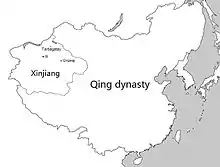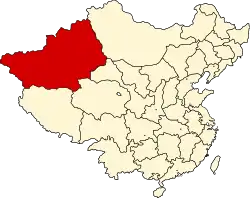Xinjiang (historical area)
Xinjiang (新疆; Uyghur: شىنجاڭ) is an area located in Central Asia, between 73 ° 5 'to 96 ° 4' east and 35 ° 5 'and 49 ° north, in total 1,660,000 square Km, share border with Mongolia, Russia, Kazakhstan, Kyrgyzstan, Tajikistan, Afghanistan, India, Pakistan and China's Tibet Autonomous Region, Qinghai Province and Gansu Province. This region had been called Western Regions (Chinese: 西域; pinyin: xīyù) in China's history and is currently known as the China's Xinjiang Uyghur Autonomous Region in provincial-level.

The name 'Xinjiang' literally means "new territory" in Chinese, had been originated in the early Qing dynasty, refers to Manchu's new conquest land, such as 'Yunnan Xinjiang' (literally "the Yunnan new territory"), 'Guangxi Xinjiang' (literally "the Guangxi new territory"). The lands of Dzungar Khanate and post Yarkent Khanate after conquered by Qing empire in the mid-18th century, was also named as 'Xiyu Xinjiang' (literally "the Western regions new territory"). This area set off a revolt against the reign of the Qing empire in the middle of the 19th century and the rebels around the regime were subsequently reunified by Yaqub Beg from West Turkestan later. In 1884, the area was conquered again by the Qing empire and set up as a province, named 'Xinjiang Province'. In the subsequent changes, the administrative area of this region has been shrinking and finally reduced to the extent of today's Xinjiang Uyghur Autonomous Region.
For the indigenous peoples of this region (mainly Turkic peoples), the word 'Xinjiang' is a foreign language word with colonialist implications and no connection to the local historical and cultural traditions. They use the name East Turkestan (Uyghur: شەرقىي تۈركىستان, Sherqiy Türkistan; Chinese: 东突厥斯坦, Pinyin: Dōng Tūjuésītǎn) to refer to this area. Due to the existence of the East Turkestan independence movement, outside the original cultural and geographical meaning, this name had a political overtones. It is not accepted by those who are against the East Turkestan independence movement. Therefore, for those opponents, East Turkestan is equal to Xinjiang (新疆).
So Xinjiang (新疆) may refer to:
Geographic Concepts
- Western regions, which basically covers the area before Qing dynasty.
- The land of Dzungar Khanate and post Yarkent Khanate after conquest by Qing empire.
- East Turkestan, as a historical, geographical and cultural concept, is the eastern part of Turkestan. Its scope is a little fuzzy, but basically quite with the territory of Xinjiang under Qing rule in Qianlong's period. As a political concept, according to East Turkestan independence movement advocates sovereignty area, its scope is quite with Xinjiang Uyghur Autonomous Region.

China's administrative divisions

.svg.png.webp)
- Xinjiang Province (Qing) (1884–1912).
- Xinjiang Province (Republic of China) (1912–1992) The actual control of the region by Republic of China was interrupted between 1933 and 1946 and ended entirely in 1949, but after the Central Government of the Republic of China moved to Taiwan, the government of Xinjiang Province (Republic of China) were abolished in 1992.
- Xinjiang Autonomous Province (Republic of China) (1933–1944) a semi-independent local government established by Sheng Shicai (盛世才, Pinyin: Shèng Shìcái) in Xinjiang Province (Republic of China).
- Xinjiang Province (People's Republic of China) (1949–1955) was replaced in 1955 by the newly established Xinjiang Uyghur Autonomous Region.
- Xinjiang Uyghur Autonomous Region, an administrative autonomous region set up by the People's Republic of China in 1954.